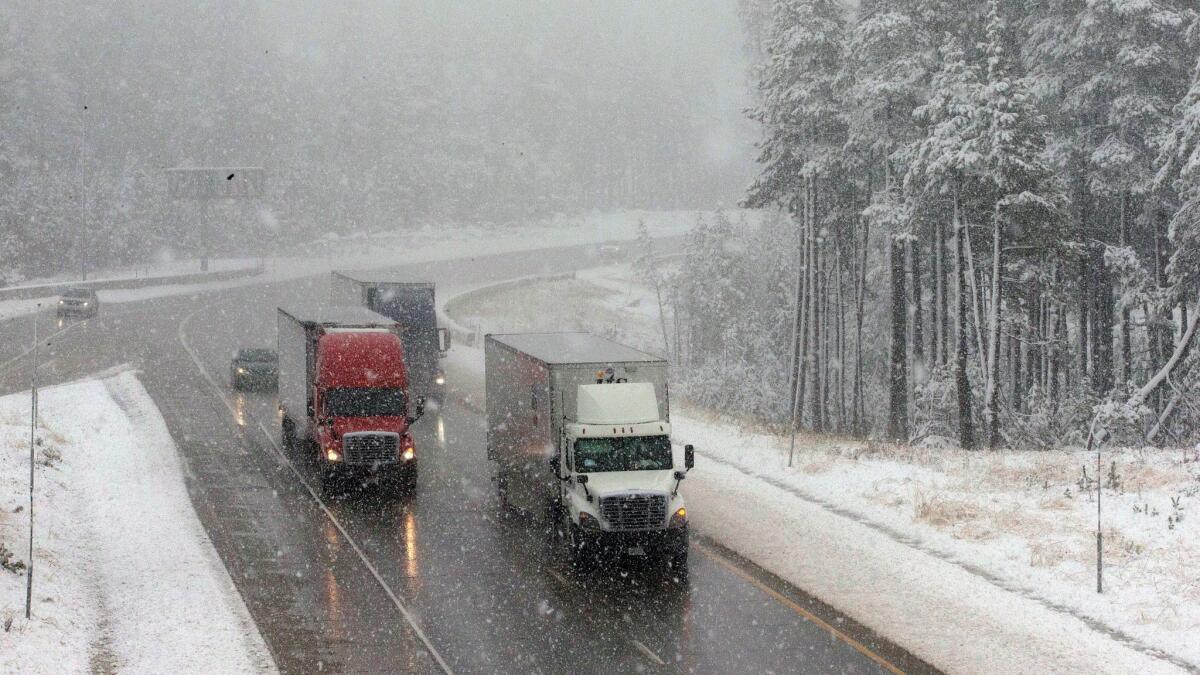Fall snow, rains have ‘satisfied the drought debt’ in Northern Sierra Nevada, climatologist says

The U.S. Drought Monitor is reporting the best outlook for California since spring 2013.
- Share via
At Heavenly Ski Resort, thousands of feet up in the northern Sierra Nevada, the heavy snowfall around Lake Tahoe forced the lodge to close its small roller coaster due to poor visibility this week.
In the days leading up to Thanksgiving, concerns over dry conditions were quickly dispatched when more than two feet of snow dropped around the lake in just two days.
Now, if past weather patterns are fulfilled this year, experts say, Northern California’s winter — and long-term relief from years of drought — could be just around the corner for the state’s most important watershed.
The Northern Sierra Nevada area has received more than 17 inches of precipitation through October and November, nearly 200% above average for the first two months of the water year, the state Department of Water Resources said. The southern portions of the Sierra Nevada, however, remain mired in drought and are only at 81% of average.
“The Northern Sierra is the source for a lot of the state’s water supplies and the state’s water projects…If we had to only get precipitation in one half of the state, having it fall up north at least puts it in the big water projects and puts it to use more broadly,” said Michael Anderson, a state climatologist. “It’s a good start we just have to see what happens from here.”

According to the National Weather Service, October’s snow and rain was four times the average in the northern Sierra Nevada. Though November’s totals were slightly below average compared to past years, the two months of precipitation added up to levels not seen since 1984-85, when there was 21.8 inches of precipitation, officials said.
“These rains have been enough to improve long-term rainfall deficits, streamflow, and soil moisture,” The U.S. Drought Report said in early November.
The region has received more than 17 inches of precipitation in that span only 11 times since record keeping began, the National Weather Service said. In 10 of those years, the region ended the water year with above average precipitation.
“We are off to a busy start for winter, and last year was a record year for us across all amenities since opening in January 1972,” said Brinn Talbot, spokeswoman for winter resort Tahoe Donner. “We are confident it is the start of another record-breaking season here.”
But the larger impact from the wet fall may not be seen for weeks or months.
Last year’s El Niño, though considered a bust in Southern California because most of the rain was steered north, has set up this year’s winter to be a potential drought-buster for some parts of the state.
Certainly, up north, we’ve satisfied the drought debt, so to speak.
— Michael Anderson, a state climatologist
On Nov. 3, the U.S. Drought Monitor reported that about a quarter of California was out of drought conditions, the best outlook the state has had since spring 2013, when 64% of the state was considered in “moderate drought” or worse.
The U.S. Drought Monitor relies heavily on precipitation levels and soil moisture to assess conditions, state water officials said. Because Northern California’s soil was essentially a dried sponge last year, much of the El Niño rains were soaked up instead of trickling into rivers, streams and reservoirs.
But this year the soil is in better condition, so a larger portion of the fall and winter snowpack that melts next spring could end up in reservoirs.
“Certainly, up north, we’ve satisfied the drought debt, so to speak,” Anderson said. “You do start getting back to where the watershed is behaving under normal conditions.”
The picture in Southern California, however, remains bleak. A bark beetle infestation that took hold in the southern and central Sierra Nevada during the drought has killed more than 100 million trees and is moving north, increasing the danger of wildfire.
When the Southland does get rain, it can be a mixed blessing, Anderson said.
“It’s a really fine line trying to get moisture into the region in a way that tips the scales on the beneficial side and treads lightly in terms of hazard like a mudslide,” he said. “It’s one of those fantastic challenges of California, where the view of the state as a whole and the view of the state on a locale can sometimes be quite different.”
The Nov. 29 Drought Report highlighted Anderson’s point. Several inches of rain were forecast for Northern California while none was expected in the south, where the National Weather Service tweeted on Friday that high winds had kicked up so much dust from a previous wildfire that it was visible from space.
For breaking California news, follow @JosephSerna on Twitter.
ALSO
Thanks to heavy rains, state may increase water delivery allocations
Cold, damaging Santa Ana winds hit 75 mph in L.A. County mountains and topple trees
Ski season begins in Southern California — with a hope and a prayer for real snow
More to Read
Sign up for Essential California
The most important California stories and recommendations in your inbox every morning.
You may occasionally receive promotional content from the Los Angeles Times.














